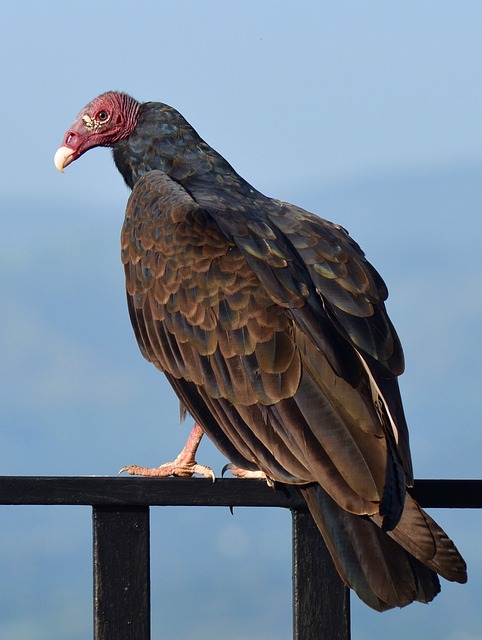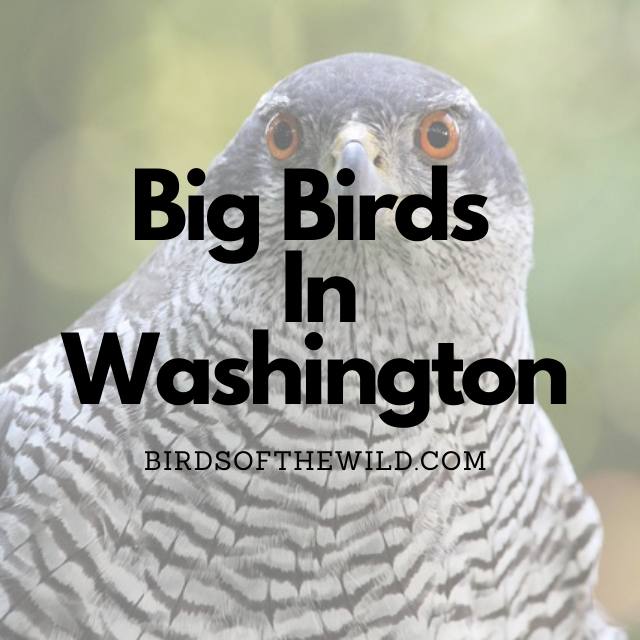Washington is home to birds of all shapes and sizes small to extremely large. In this article I’ll be going over 7 unique big birds that can be found throughout the state of Washington so, continue reading to learn a bit more about them.
- Northern Goshawk
- Red Tailed Hawk
- Great Horned Owl
- Bald Eagle
- Golden Eagle
- Osprey
- Turkey Vulture
7 Big Birds In Washington
1. Northern Goshawk (Accipiter Gentilis)

- Size: 55 – 61cm
- Weight: 0.63 – 1.4kg
- Wingspan: 105 – 115cm
Northern goshawks are mostly year round residents within the state although in the more central regions of Kansas, they only remain when they aren’t breeding.
These hawks are recognised by their moslty gray and white plumage with a horizontal zebra like gray pattern across their belly and breasts. The females are generally a more brown color and are also bigger in size.
You’ll often spot northern goshawks around deciduous and coniferous forests.
They’ll generally feed on smalller rodents, mammals and birds like snowshoe hare, rabbit, gray and red squirrels, chipmunks, weasels, ducks, grouse, quail, pheasants, crows, small hawks, owls, woodpeckers, blackbirds, blue jays, grasshoppers, as well as insects like moth and beetle larvae.
Northern goshawks are known to live for around 7 years on average, with the longest living ones achieving a lifespan of 19 years.
2. Red Tailed Hawk (Buteo Jamaicensis)

- Size: 45 – 60cm
- Weight: 1.25 – 1.47kg
- Wingspan: 100 – 150cm
You’ll be able to spot red tailed hawks in Washington year round.
Red tailed hawks are recognised by their brown torso and wings, white breast and red tails. The main difference between the male and females is that the females are a third larger than the males.
These red tailed avians spend their time at a variety of places within the state including deserts, grasslands, forests, agricultural fields and urban areas.
Red tailed hawks are carnivorous birds of prey where they feed on small mammals, rodents, other smaller birds, fish and even carrion.
In the wild red tailed hawks are known to live between 15 – 20 years whilst captive red tails can live on the upper end of that spectrum around 20 years.
3. Great Horned Owl (Bubo Vrginianus)

- Size: 57 – 63cm
- Weight: 1.4 – 15kg
- Wingspan: 1.35 – 1.5m
Great horned owls are year round residents within the state of Washington.
These large horned owls are recognised by their brown/gray plumage with their defining feature being the tuft of feather on the top of their head resembling a horn or ear like feature. Male and female great horned owls look relatively the same with the females slightly larger in size.
At night these birds will perch on a branch or a tall building to look around for prey and once the desired prey has been found they will fly towards it with folded wings, grab the prey with their talons piercing through their body and in most cases killing them immediatley.
As for what these birds eat it includes smaller prey like rodents, frogs or scorpions. Even other larger predators like geese, ducks, hawks, and smaller owls can be eaten by these carnivorous birds.
Great horned owls are most commonly found in deserts, wetlands, forests, grasslands, backyards, cities and they can also be found in semi-open habitats between the Arctic and the tropics.
As for a great horned owls lifespan, it can be anywhere from 15 -25 years.
4. Bald Eagle (Haliaeetus Leucocephalus)

- Size: 90 – 108cm
- Weight: 3 – 6.3kg
- Wingspan: 180 – 250cm
Blad eagles are mostly winter residents within Washington although some may stay year round nearer the western border of the state.
A bald eagle’s plumage consists of dark brown around its wing and body, with white feathers on its tail and head along with the trademark yellow beak and feet. Both male and female bald eagles look relatively the same.
As for where you can find these eagles, it will often be around lakes and reservoirs with lots of fish and surrounding forests. You’ll often find them around unfrozen lakes and hunting along coastlines, reservoirs, and rivers during the winter months
These eagles are birds of prey meaning they hunt other birds, medium sized mammals like rabbits, hares, other animals like reptiles, fish and even eat carrion when their options are limited. Sometimes bald eagles are recognised as fish eagles as their diet consists of fish and as meat is the only thing they eat these eagles would ultimately be regarded as carnivores too.
Blad eagles can live for around 20 years in the wild.
5. Golden Eagle (Aquila Chrysaetos)

- Size: 70 – 82cm
- Weight: 3.7 – 5.3kg
- Wingspan: 190 – 212cm
You’ll be able to spot golden eagels in all of Washington year round as it’s one of their many permanent places of residence within the states.
Golden eagles are recognised by their mostly light brown and dark brown plumage, yellow feet and black downwards pointing beak. Females once again are the larger of the 2 birds where males are roughly 33% smaller in size.
These eagles spend the majority of their time within open moorlands and mountains within the likes of Scotland, and many areas within north America
Golden eagles do eat carrion but, it isn’t their first choice of food when hunting for prey. If they do find a dead carcass they will eat it, with their general food choices consisting of smaller mammals, birds and sometimes larger prey.
These eagles are known to live for around 14 years in the wild whilst captive are even able stay alive till their early 30’s with the longest observed at 32 years old.
6. Osprey (Pandion Haliaetus)

- Size: 50 – 65cm
- Weight: 1 – 1.5kg
- Wingspan: 170 – 185cm
You’ll be able to find ospreys in Washington throughout their breeding season. This will normally be around the spring and summer months.
Ospreys are recognised by their brown wings and back, white neck and belly with hints of brown around the neck, with a black beak and yellow eyes. The male and females are very similar in appearance although the females are roughly 20% larger.
Ospreys can be found around large watercourses such as rivers, lakes or coastal areas.
As for what they eat, it includes mostly fish from medium-sized fish such as salmon, trout, flounder and mullet, along with the odd smaller ones too.
These big birds have been observed to live for around 15 – 20 years on average with the longest recorded age being 32 years.
7. Turkey Vulture (Cathartes Aura)

- Size: 62 – 81cm
- Weight: 1.5 – 2 kg
- Wingspan: 160 – 180cm
You’ll be able to spot turkey vultures in Washington when they happen to go through breeding. This will normally be around the summer and spring months.
Turkey vultures have a plumage that is mostly brownish/black in color with silver/gray lining on the underside of their wings adding a contrast to their overall appearance. The face is pink/red with elements of black on the head topped of with a pale white beak.
These scavengers are mono-morphic so they do look the same with the only differentiating aspect being their sexual organs.
Turkey vultures are scattered throughout north America where they can be found staying within open and forested habitats where they will also stay within lower elevation mountain ranges.
Carrion is a turkey vultures primary food source but, they do also eat dead reptiles, birds, amphibians and invertebrates. As a whole these vultures do prefer fresher carrion but, like other vultures they can consume the same carcass over several days.
Turkey vultures are known to live for around 16 years in the wild and up to 30 years in captivity.
Amhil Khan, a dedicated nature enthusiast and the founder of BirdsOfTheWild.com, is a passionate advocate for the captivating world of avian wonders. With a deep-seated curiosity about the intricate lives of birds, Amhil’s journey began as a fascination and has evolved into a mission to inspire others to appreciate and protect these magnificent creatures.
Amhil’s love for birds led to the creation of Birds of the Wild, a platform where his expertise in ornithology, coupled with his captivating storytelling, provides readers with an immersive and educational experience. Through his lens and words, he captures the essence of birds in their natural habitats, offering a glimpse into their behaviors, migrations, and the ecosystems they inhabit.

